Freshwater Sharks in Home Tanks: Meet 15+ Bold and Beautiful Species
Think you need a saltwater setup to own a shark? Think again. While they’re not true sharks, freshwater “sharks” like the Bala Shark and Rainbow Shark offer a bold, exciting presence in medium to large aquariums. With their sleek bodies, active behavior, and striking colors, these fish bring a touch of the wild into your living room—without the bite.
But don’t be fooled by their appeal: freshwater sharks have specific care requirements and temperament quirks that every aquarist should understand before adding them to a tank.
In this guide, we’ll take a closer look at two of the most popular freshwater shark species, exploring their size, habitat needs, compatibility, and behavior. Whether you’re planning a showpiece tank or expanding your freshwater community, this article will help you decide which shark—if any—is the right fit for your aquatic setup.
- The Truth About Freshwater Sharks
- Top Freshwater Sharks for Home Aquariums
- 1. Bala Shark
- 2. Rainbow Shark
- 3. Albino Rainbow Shark
- 4. Glo Sharks (Cosmic Blue, Galactic Purple, Electric Green)
- 5. Red Tail Shark
- 6. Chinese High-Fin Banded Shark
- 7. Siamese Algae Eater
- 8. Flying Fox Shark
- 9. Apollo Shark
- 10. Iridescent Shark
- 11. Columbian Shark
- 12. Black Sharkminnow
- 13. Roseline Shark
- 14. Harlequin Shark
- 15. Violet Blushing Shark
- Conclusion
The Truth About Freshwater Sharks
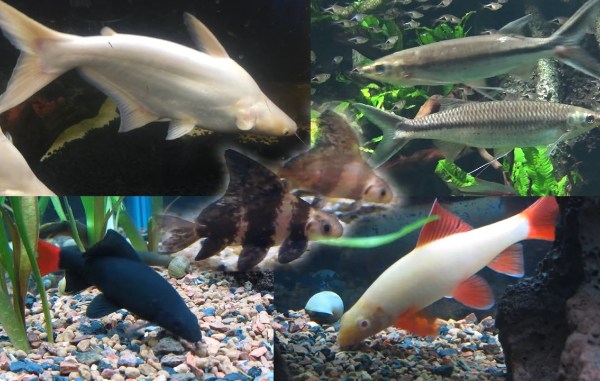
Before diving into specific species, it’s essential to clarify that freshwater sharks are not true sharks. These fish belong to the Cyprinidae family (or, in some cases, catfish families) and are named “sharks” due to their physical resemblance to their marine counterparts. They typically feature a sleek, torpedo-shaped body, a prominent dorsal fin, and a forked tail, mimicking the iconic shark profile. Unlike true sharks, which are cartilaginous fish in the Chondrichthyes class, freshwater sharks are bony fish, making them safer and more manageable for home aquariums.
While some species may exhibit semi-aggressive behaviors, they are generally far less dangerous than their saltwater namesakes. However, their care requirements, tank size, and compatibility with other fish vary significantly, so careful planning is crucial. Most freshwater sharks hail from Southeast Asia, belonging to the Cyprinidae family, though some, like the Iridescent Shark, are catfish. This guide focuses on the Bala Shark and Rainbow Shark, two of the most popular choices, with detailed care instructions and unique insights.
Top Freshwater Sharks for Home Aquariums
1. Bala Shark
 Live Bala Shark for sale from Amazon #ad
Live Bala Shark for sale from Amazon #ad
- Scientific Name: Balantiocheilos melanopterus
- Care Level: Easy to Medium
- Temperament: Peaceful
- Lifespan: Up to 10 years
- Size: Up to 14 inches (36 cm)
- Tank Size: Minimum 150 gallons (570 liters)
- Water Parameters: 72–82°F (22–28°C), pH 6.0–8.0, hardness 5–12 dGH
- Diet: Omnivore
The Bala Shark, also known as the Silver Shark or Tricolor Shark, is a striking addition to large freshwater aquariums. With its silvery, iridescent body and black-tipped dorsal, caudal, anal, and pelvic fins, it embodies the shark-like aesthetic that makes it a favorite among aquarists. Native to the fast-flowing rivers and lakes of Southeast Asia (Malay Peninsula, Sumatra, and Borneo), this species is a shoaling fish that thrives in groups of six or more, reducing stress and promoting natural behaviors.
Bala Sharks are highly social fish known for their striking, synchronized swimming when kept in groups. Watching a school glide together through open water creates a dynamic, mesmerizing display. However, they are sensitive to group size—keeping fewer than six can lead to stress, lethargy, or even early death. Despite their peaceful nature, Bala Sharks are extremely active and notorious for jumping, sometimes leaping several feet when startled. A secure lid is absolutely essential.
In the wild, Bala Sharks are considered endangered due to overfishing, pollution, and habitat loss. Thankfully, most individuals in the aquarium trade are farm-bred, though natural breeding in captivity remains rare. One of the biggest surprises for new owners is their growth rate: juveniles may be sold at just a few inches, but they can reach up to 14 inches and require very large aquariums. A long, spacious tank with open swimming areas is ideal, as they are fast swimmers that can easily knock over loose decorations.
Though omnivorous, Bala Sharks are not destructive to plants and generally coexist well in planted aquariums when given a varied diet. They thrive alongside other peaceful, medium-to-large fish like gouramis, rainbowfish, tinfoil barbs, and clown loaches, but may view much smaller fish as food once fully grown. Due to their nervous disposition, it’s best to house them in calm environments away from constant activity or loud disturbances.
2. Rainbow Shark
 Live Rainbow Shark for sale from Amazon #ad
Live Rainbow Shark for sale from Amazon #ad
- Scientific Name: Epalzeorhynchos frenatum
- Care Level: Intermediate
- Temperament: Semi-aggressive
- Lifespan: 5–8 years
- Size: 4–6 inches (10–15 cm)
- Tank Size: Minimum 50 gallons (190 liters)
- Water Parameters: 72–79°F (22–26°C), pH 6.5–7.5, hardness 5–15 dGH
- Diet: Omnivore
The Rainbow Shark, also known as the Red-Finned or Ruby Shark, is a vibrant freshwater fish with a dark gray, blue, or black body and striking red or orange fins. Native to Southeast Asian rivers (e.g., Mekong, Chao Phraya), this bottom-dwelling species is popular for its shark-like profile and active behavior. However, its territorial nature requires careful tank planning.
Rainbow Sharks are striking and solitary bottom-dwellers known for their territorial behavior, especially as they mature. While visually captivating, they can become aggressive toward similar-looking fish like Red Tail Sharks or even midwater species like Bala Sharks. For this reason, they are best kept alone unless housed in a very large tank with plenty of hiding spots and broken lines of sight.
Unlike Bala Sharks that prefer open water, Rainbow Sharks patrol the lower regions of the aquarium, weaving through caves and dense decorations. Their constant foraging can disturb poorly rooted plants, so sturdier species like Java Moss or Java Fern are better suited. A well-balanced, protein-rich diet is key to maintaining their vivid coloration—juveniles fed improperly may develop dull fins or stunted growth.
Although breeding in captivity is rare due to their aggression, most Rainbow Sharks in the trade are commercially bred using hormone-induced methods. Hobbyist breeding attempts require a separate, closely monitored tank to prevent fighting.
Rainbow Sharks do best with mid- or upper-level tank mates such as barbs, danios, gouramis, and rainbowfish. However, they tend to clash with other bottom-dwellers or similarly shaped species. Their aggressive tendencies are most manageable when they are introduced last into the tank, minimizing early territorial claims.
Though hardy, Rainbow Sharks are sensitive to poor water conditions and thrive in clean, well-oxygenated environments with steady water flow. A thoughtfully arranged tank—with caves, driftwood, and shaded retreats—not only supports their natural behavior but also helps reduce stress and territorial outbursts. Given the right environment, Rainbow Sharks can be both a dramatic centerpiece and a dynamic addition to large, well-managed aquariums.
3. Albino Rainbow Shark
- Scientific Name: Epalzeorhynchos frenatum
- Care Level: Intermediate
- Temperament: Semi-aggressive
- Lifespan: 5–8 years
- Size: Up to 5 inches (12 cm)
- Tank Size: Minimum 50 gallons (190 liters)
- Water Parameters: 72–79°F (22–26°C), pH 6.5–7.5, hardness 5–15 dGH
- Diet: Omnivore
The Albino Rainbow Shark is a visually stunning variation of the classic Rainbow Shark, distinguished by its pearly white body and vivid red or orange fins, often tipped with a subtle iridescent sheen. Native to Southeast Asian rivers like the Mekong, this bottom-dwelling fish shares many traits with its darker counterpart, including a strong territorial instinct and a preference for solitude in home aquariums.
This albino variant is less common and typically bred in captivity, making it a sought-after choice for aquarists looking to add unique color to their tanks. However, their pale coloration is sensitive to stress, poor water conditions, or inadequate diet, and may fade if not properly cared for. In the right setup—with stable water quality and a varied diet—they can maintain a radiant appearance that stands out beautifully against a dark substrate or background.
Like all Rainbow Sharks, the albino form is best housed alone unless kept in a very large tank with ample hiding places to minimize territorial aggression. They tend to stake out the lower levels of the tank, often defending caves or dense decor as their personal domain. A well-structured aquascape with driftwood, rocks, and robust plants not only enriches their environment but also helps reduce confrontations with other fish.
Though peaceful under the right conditions, Albino Rainbow Sharks can be aggressive toward other bottom dwellers or fish with a similar shape. They pair best with mid- and top-level swimmers like barbs, gouramis, danios, or rainbowfish—species that stay out of their way. Introducing them last into an established community tank can also help curb territorial behavior.
While breeding is rarely successful in home aquariums due to their solitary and aggressive nature, most specimens in the hobby are farm-raised with hormone assistance. Nonetheless, with their vibrant colors and bold presence, Albino Rainbow Sharks remain a captivating addition for experienced aquarists ready to accommodate their specific needs.
4. Glo Sharks (Cosmic Blue, Galactic Purple, Electric Green)
 GloFish Live Fish Collections with Glo shark #ad
GloFish Live Fish Collections with Glo shark #ad
- Scientific Name: Epalzeorhynchos frenatum
- Care Level: Intermediate
- Temperament: Semi-aggressive
- Lifespan: 5–8 years
- Size: Up to 6 inches (15 cm)
- Tank Size: Minimum 50 gallons (190 liters)
- Water Parameters: 72–79°F (22–26°C), pH 6.5–7.5, hardness 5–15 dGH
- Diet: Omnivore
Glo Sharks are eye-catching, genetically modified variants of the Rainbow Shark, engineered to display vivid hues like Cosmic Blue, Galactic Purple, and Electric Green. Created through the infusion of fluorescent jellyfish proteins, these fish glow brilliantly under actinic or blue-spectrum lighting, making them an instant focal point in any aquarium. While their neon appearance sets them apart, their behavior and care needs are nearly identical to those of their non-glowing cousins.
Territorial and solitary by nature, Glo Sharks are best kept as single specimens unless housed in very large aquariums with extensive hiding spots. Like Rainbow Sharks, they claim the bottom of the tank as their domain, often patrolling caves, driftwood, or dense decor. Though generally peaceful with mid- and upper-level fish, they can become aggressive if space or visual barriers are limited.
What makes Glo Sharks truly shine—literally—is the right lighting. Their fluorescent proteins react best to blue LED or actinic lights, especially when paired with dark substrates and backgrounds that heighten contrast. Inadequate lighting or overly bright white light can mute their signature glow, so a carefully chosen setup is key to showcasing their brilliance.
Despite their modified origins, Glo Sharks are robust and adapt well to typical freshwater conditions when properly maintained. Ethical concerns have arisen around their genetic engineering, and they are restricted in some countries, particularly in Europe. However, in closed aquarium systems, they pose no ecological threat and are widely embraced by hobbyists who value their unique appearance.
Glo Sharks thrive on a varied omnivorous diet and can coexist with barbs, danios, larger tetras, and even other GloFish species like fluorescent tetras and danios. As with other territorial species, it’s best to introduce them last into a community tank to prevent early dominance.
With their bold colors and classic shark-like silhouette, Glo Sharks offer a blend of spectacle and personality. For those seeking a conversation piece with an edge, they’re a glowing example of how science and aquascaping can create something truly extraordinary.
5. Red Tail Shark
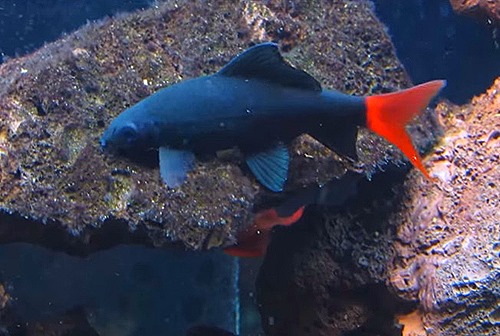
- Scientific Name: Epalzeorhynchos bicolor
- Care Level: Intermediate
- Temperament: Semi-aggressive
- Lifespan: 5–8 years
- Size: Up to 6 inches (15 cm)
- Tank Size: Minimum 55 gallons (208 liters)
- Water Parameters: 72–79°F (22–26°C), pH 6.0–8.0, hardness 5–15 dGH
- Diet: Omnivore
The Red Tail Shark is a striking freshwater fish known for its jet-black body contrasted by a vibrant, flame-red tail. Native to Thailand’s Chao Phraya River basin, this active bottom-dweller has become a staple in the aquarium hobby—not just for its appearance, but for its strong personality. Closely related to the Rainbow Shark, it shares the same territorial tendencies and is best kept as a single specimen in most home tanks.
Though critically endangered in the wild due to habitat loss, Red Tail Sharks continue to thrive in the aquarium trade thanks to captive breeding. Their signature coloration—deep black against glowing red—is maintained through selective breeding and a nutrient-rich diet. A mix of protein-heavy foods, with occasional plant matter, helps preserve their vivid contrast.
Red Tail Sharks are constantly on the move, patrolling the lower regions of the tank and claiming caves or decorations as their own. While they usually ignore fish that stay in the upper levels, they can be aggressive toward intruders in their territory. A carefully scaped tank—with caves, driftwood, and hardy plants—helps create distinct zones and reduces the risk of conflict.
These fish pair best with active mid- and top-level species like barbs, gouramis, and rainbowfish. However, they should not be kept with other bottom-dwellers or similar shark-like fish, including other Red Tail or Rainbow Sharks. Introducing them last into a community tank can also help minimize territorial behavior.
With proper space, structure, and stable water conditions, Red Tail Sharks become confident and eye-catching inhabitants. They offer both visual drama and dynamic movement, making them ideal for experienced aquarists who can accommodate their bold nature.
6. Chinese High-Fin Banded Shark
- Scientific Name: Myxocyprinus asiaticus
- Care Level: Intermediate to Advanced
- Temperament: Peaceful
- Lifespan: 10–15 years
- Size: Up to 4 feet (1.2 meters)
- Tank Size: 300–800 gallons (1135–3028 liters)
- Water Parameters: 55–75°F (13–24°C), pH 6.0–7.5, hardness 4–20 dGH
- Diet: Omnivore
The Chinese High-Fin Banded Shark begins life as a stunning juvenile, often mistaken for a fancy goldfish due to its bold black-and-white bands and dramatic sail-like dorsal fin. Native to the cool, fast-moving waters of China’s Yangtze River, this peaceful bottom-dweller undergoes a striking transformation as it matures—its bold markings fade into a muted brown, its fin flattens, and its body grows to an impressive 3 to 4 feet in length.
This rapid and dramatic growth catches many aquarists off guard, as young fish are commonly sold in small sizes. However, they quickly outgrow typical home aquariums and are best suited for spacious indoor setups or large outdoor ponds, especially those designed for koi. Their peaceful temperament and cold-water preference make them ideal companions for koi and other large, non-aggressive fish, provided the water is well-oxygenated and consistently cool.
Unlike most freshwater “sharks,” the Chinese High-Fin Banded Shark thrives in cooler temperatures, generally between 55–75°F. Warm conditions can lead to stress and health issues, so temperature regulation is crucial—especially in warmer climates, where chillers may be necessary.
In the wild, this species has suffered significant population declines due to overfishing and habitat loss, though most individuals in the aquarium trade today are farm-raised. Despite their size and environmental needs, their gentle nature makes them a beloved addition to large-scale setups for those who can accommodate them.
While they will occasionally graze on plants, their diet should be varied to support health and color—ranging from sinking pellets and algae wafers to vegetables and protein-rich frozen foods. They coexist best with other large, peaceful species and should not be housed with aggressive tank mates or small fish that may be mistaken for food.
For aquarists with the space and resources, the Chinese High-Fin Banded Shark offers a rewarding long-term companion—majestic, serene, and ever-evolving.
7. Siamese Algae Eater
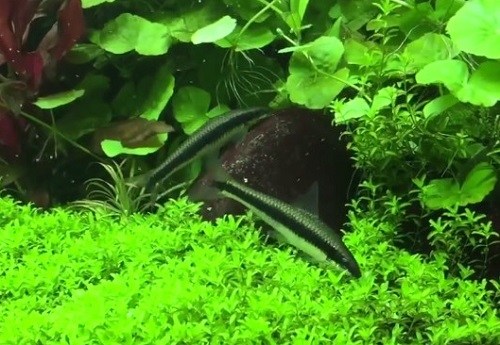
- Scientific Name: Crossocheilus oblongus (often C. langei for true algae eaters)
- Care Level: Easy
- Temperament: Peaceful
- Lifespan: Up to 10 years
- Size: Up to 6 inches (15 cm)
- Tank Size: Minimum 25–30 gallons (95–115 liters)
- Water Parameters: 75–79°F (24–26°C), pH 6.5–7.0, hardness 5–10 dGH
- Diet: Omnivore
The Siamese Algae Eater (particularly Crossocheilus langei) has earned a reputation as one of the most effective algae grazers in the freshwater aquarium world. Small, peaceful, and hardworking, these fish are especially prized for their unique appetite for black brush algae (BBA)—a nuisance few other species touch. Native to the streams and rivers of Southeast Asia, they make an excellent addition to planted community tanks, where they contribute both utility and personality.
Among its close relatives, C. langei stands out for its superior algae-eating ability. True Siamese Algae Eaters can be recognized by a solid black stripe running from the snout through the tail fork—this line may fade slightly when the fish is stressed but always returns. It’s worth noting that they’re often confused with Flying Foxes or Chinese Algae Eaters, which differ significantly in temperament and effectiveness.
These fish prefer the company of their own kind. Kept in small groups of 3 to 5, they exhibit more natural, relaxed behaviors and spend their time foraging calmly among plants and driftwood. Their peaceful nature makes them highly compatible with most small community species, and unlike many so-called freshwater “sharks,” they are exceptionally plant-friendly—making them ideal for lush aquascapes.
In terms of habitat, a 25- to 30-gallon tank is enough for a small group, though larger setups offer more swimming space and stability. These fish thrive in well-maintained aquariums with moderate flow, soft substrates, and live plants like Cryptocoryne or Anubias, which also provide surfaces for algae growth. Stable water quality and regular maintenance are key to keeping them healthy.
Although they’re primarily algae grazers, Siamese Algae Eaters benefit from a balanced diet. Offer algae wafers, sinking pellets, and blanched vegetables such as zucchini or spinach. Occasional feedings of live or frozen foods like brine shrimp can add variety. However, the presence of natural algae in the tank remains essential for both their health and activity.
For aquarists seeking a peaceful, purposeful fish that actively contributes to tank cleanliness, the Siamese Algae Eater is an ideal choice. Quietly patrolling the tank with tireless focus, they are not just janitors—but part of the aesthetic harmony of a well-planted aquarium.
8. Flying Fox Shark
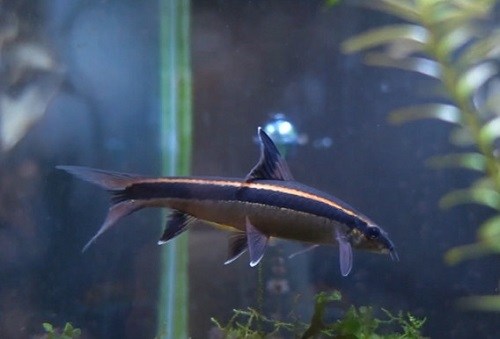
- Scientific Name: Epalzeorhynchos kalopterus
- Care Level: Easy
- Temperament: Peaceful to Semi-aggressive
- Lifespan: Up to 15 years
- Size: Up to 6 inches (15 cm)
- Tank Size: Minimum 55 gallons (208 liters)
- Water Parameters: 74–81°F (23–27°C), pH 6.5–7.3, hardness 5–15 dGH
- Diet: Omnivore
The Flying Fox Shark (Epalzeorhynchos kalopterus) begins life as a peaceful, hardworking algae eater—but as it matures, its personality and dietary needs shift. Native to the fast-moving streams and rivers of Southeast Asia, this torpedo-shaped fish is often confused with the Siamese Algae Eater due to its similar coloration. However, the Flying Fox is a distinct species with its own care requirements and quirks.
Young Flying Foxes are efficient algae grazers, helping to keep tanks tidy. But as they age, their appetite broadens to include more omnivorous fare, and their algae-cleaning habits diminish. They may even nibble on soft plants if left underfed, so providing a diverse diet is essential to minimize damage in planted tanks.
Identifying a Flying Fox is straightforward when you know what to look for: the black horizontal stripe along the body is edged in gold—a detail that sets them apart from the true Siamese Algae Eater. While peaceful as juveniles, adult Flying Foxes can become semi-aggressive, especially toward similar-looking tankmates like Rainbow Sharks or other algae eaters. That territorial streak makes thoughtful tankmate selection important.
With proper care, these fish can live up to 15 years, so they are best suited for aquarists looking for a long-term companion. A minimum tank size of 55 gallons is required, though 75 gallons or more is preferred for community setups. Their active nature calls for open swimming space, moderate water flow, and a few secure hiding spots such as caves or driftwood crevices to diffuse potential aggression.
Flying Foxes do well in planted tanks—as long as their dietary needs are met. Feeding them algae wafers, sinking pellets, blanched vegetables (like cucumber or zucchini), and occasional frozen foods such as bloodworms keeps them healthy and less inclined to snack on your plants.
When it comes to tankmates, choose fast, mid- or top-dwelling species like danios, barbs, or larger tetras that won’t trigger territorial behavior. Avoid other bottom-dwelling lookalikes, including Rainbow Sharks or Siamese Algae Eaters, to reduce conflict.
9. Apollo Shark
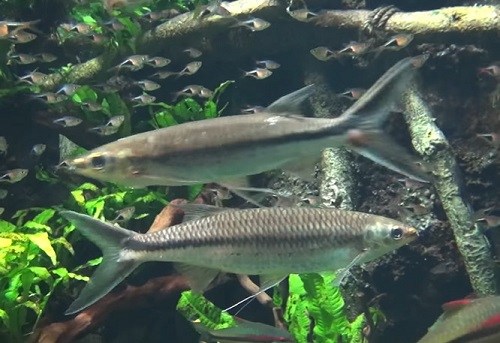
- Scientific Name: Luciosoma spilopleura
- Care Level: Easy to Intermediate
- Temperament: Peaceful
- Lifespan: Up to 14 years
- Size: Up to 10 inches (25 cm)
- Tank Size: Minimum 125 gallons (473 liters)
- Water Parameters: 68–77°F (20–25°C), pH 6.0–6.5, hardness 4–10 dGH
- Diet: Omnivore
The Apollo Shark (Luciosoma spilopleura) is a streamlined, silver-hued beauty known for its fast swimming and peaceful schooling behavior—at least when kept in proper numbers. Native to the flowing rivers of Southeast Asia, this species is a great choice for advanced aquarists who want the appearance of a freshwater “shark” without the aggression.
Though peaceful with similarly sized fish, Apollo Sharks have a natural predatory instinct and may eat smaller tank mates like neon tetras. For this reason, tank mate selection is key. They thrive in schools of six or more, which helps reduce stress and creates an impressive display of synchronized movement in larger aquariums.
Many hobbyists confuse L. spilopleura with the Long-Finned Apollo Shark (Luciosoma setigerum), a more aggressive species. Make sure you’re getting the right one for a community tank by verifying the scientific name at purchase.
Because of their size and activity level, these fish require a long, spacious tank—ideally 5 to 6 feet in length. A 125-gallon setup is the minimum for a small group, though larger is better. Provide open swimming areas with minimal obstruction, using decor like driftwood and sparse plantings to define space without crowding the tank.
10. Iridescent Shark
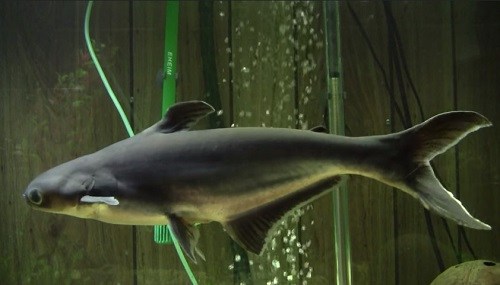
Iridescent shark
- Scientific Name: Pangasianodon hypophthalmus
- Care Level: Advanced
- Temperament: Peaceful
- Lifespan: Up to 20 years
- Size: Up to 48 inches (1.2 meters)
- Tank Size: Minimum 300 gallons (1135 liters)
- Water Parameters: 72–79°F (22–26°C), pH 6.5–7.5, hardness 5–20 dGH
- Diet: Omnivore
Despite its name, the Iridescent Shark is not a true shark but a type of freshwater catfish. It earns its nickname from its sleek, gunmetal gray body and streamlined shape, which closely resembles that of oceanic sharks. Native to the vast river systems of Southeast Asia, particularly the Mekong and Chao Phraya, this species is known for its graceful swimming and peaceful nature.
Juvenile Iridescent Sharks are often sold at just a few inches long, but they grow rapidly—often reaching lengths of up to 4 feet (1.2 meters). This dramatic growth makes them a poor fit for most home aquariums. Instead, they are best kept in large public aquariums or spacious outdoor ponds. These fish are naturally social and prefer the company of their own kind, typically thriving in groups of three to five. However, schooling behavior adds to their already significant space needs.
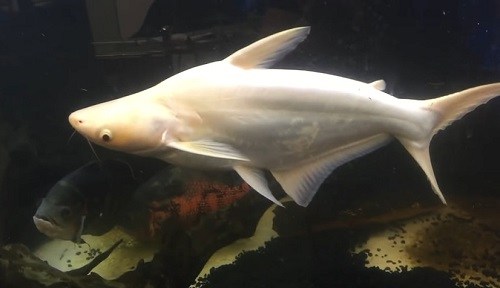
Albino Iridescent shark
One of the most popular variants is the Albino Iridescent Shark, prized for its pale, luminous body that reflects light beautifully in well-lit tanks. Both the standard and albino forms have a shimmering quality to their skin that enhances their visual appeal.
Though relatively hardy, Iridescent Sharks are sensitive to poor water conditions, especially low oxygen levels and high nitrate concentrations. They require a well-maintained tank with ample swimming space, moderate water flow, and consistent oxygenation to thrive. Moderate lighting can bring out their iridescent sheen, making them even more striking to observe.
With their shark-like appearance, large size, and calm temperament, Iridescent Sharks make an impressive centerpiece in massive freshwater displays. They are a favorite among experienced aquarists who can meet their long-term space and water quality needs.
11. Columbian Shark
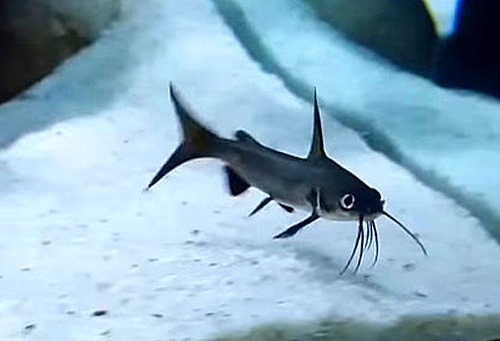
- Scientific Name: Arius jordani
- Care Level: Intermediate to Advanced
- Temperament: Peaceful
- Lifespan: 10–15 years
- Size: 10–14 inches (25–35 cm)
- Tank Size: Minimum 75 gallons (284 liters)
- Water Parameters: 75–80°F (24–27°C), pH 7.0–8.0, salinity 1.005–1.015 SG (brackish as adults)
- Diet: Omnivore
The Columbian Shark is a sleek, silver-bodied catfish often mistaken for a freshwater species due to its juvenile tolerance of freshwater environments. However, this fish naturally inhabits brackish estuaries in Central and South America, and as it matures, it requires a gradual shift to brackish conditions to remain healthy. Its torpedo-shaped body and active swimming style give it a distinctly shark-like appearance, making it a favorite among aquarists seeking a bold, predatory look in their tanks.
A notable feature of the Columbian Shark is its venomous dorsal and pectoral spines. These can cause painful stings if handled carelessly, so caution is essential when cleaning the tank or transferring the fish. While peaceful in demeanor, this species is a predator by nature and may view smaller tank mates as food, especially as it grows. Fish such as guppies or small tetras are at risk, so tank mates should be chosen with care.
Many aquarists unknowingly purchase this fish under the impression that it is fully freshwater-compatible. This common misconception often leads to health problems or early mortality, as adult Columbian Sharks thrive only in brackish water with salinity ranging from 1.005 to 1.015 specific gravity. Achieving this requires a gradual acclimation process over time using marine salt and a hydrometer to monitor salinity.
Because of their size and activity level, these fish need a spacious tank—75 gallons at minimum for juveniles, with over 100 gallons recommended for adults or groups. A sandy substrate, pieces of driftwood, and hardy plants that can tolerate brackish conditions help create a comfortable environment. While they may nibble on some vegetation, using resilient species like Java Fern can help maintain a balanced tank layout.
Overall, the Columbian Shark is an impressive, fast-swimming species that adds dynamic energy to large brackish aquariums. Its care demands a bit more research and planning than typical freshwater fish, but for aquarists ready to manage the brackish transition and handle it safely, it can be a striking and rewarding addition.
12. Black Sharkminnow

- Scientific Name: Labeo chrysophekadion
- Care Level: Intermediate to Advanced
- Temperament: Aggressive
- Lifespan: 10–15 years
- Size: 30–35 inches (76–90 cm)
- Tank Size: Minimum 250 gallons (950 liters)
- Water Parameters: 68–79°F (20–26°C), pH 6.5–7.5, hardness 5–15 dGH
- Diet: Omnivore
The Black Sharkminnow is a bold and visually striking fish, recognized by its deep-black coloration and powerful, shark-like silhouette. Native to the river systems of Southeast Asia, it is a highly active and territorial species that brings both beauty and challenge to large freshwater aquariums. Its commanding presence and fast, darting movements make it a standout fish—but also one that demands thoughtful tank planning and ample space.
This species is known for its aggressive temperament, especially toward smaller or similarly shaped tank mates. It tends to establish and fiercely defend its territory, making it best kept alone unless housed in an exceptionally large aquarium or pond of over 500 gallons. Even in spacious environments, careful attention to tank layout and population is needed to prevent conflict.
Growing up to 35 inches in length, the Black Sharkminnow outgrows typical aquarium setups rather quickly. A minimum of 250 gallons is recommended for a single adult, with significantly more space required for cohabitation. Despite its robust nature, it is sensitive to water conditions—particularly ammonia and nitrite spikes—which can make it vulnerable to stress-related diseases like Ich. Clean, well-filtered water with strong circulation and high oxygenation is essential to maintain its health.
In terms of habitat, a sandy substrate mimics its natural riverbed environment and enhances its dark coloration. Sparse decorations like driftwood and hardy plants such as Java Fern provide both structure and some visual relief, though the fish may uproot or nibble on more delicate vegetation. Keeping its diet varied—with sinking pellets, live or frozen invertebrates, and blanched vegetables—can help reduce plant damage and support long-term well-being.
Due to its size and disposition, compatible tank mates must be chosen with care. Only other large, fast, and upper-level swimming species like tinfoil barbs or arowanas are appropriate. Smaller fish or other bottom-dwelling species are likely to be bullied or attacked, especially in confined spaces.
With its dramatic appearance and dominant behavior, the Black Sharkminnow is best suited for experienced aquarists who can meet its substantial space and environmental needs. When properly housed and maintained, it becomes a commanding centerpiece fish—both beautiful and formidable.
13. Roseline Shark

- Scientific Name: Sahyadria denisonii
- Care Level: Easy
- Temperament: Peaceful
- Lifespan: Up to 5 years
- Size: Up to 6 inches (15 cm)
- Tank Size: Minimum 55 gallons (208 liters)
- Water Parameters: 60–77°F (15–25°C), pH 6.5–7.8, hardness 5–20 dGH
- Diet: Omnivore
The Roseline Shark, also known as the Denison Barb, is a striking and peaceful species prized for its vivid coloration and graceful swimming. With a bold red stripe running from snout to tail and shimmering, iridescent scales, this fish brings dynamic beauty to any well-maintained freshwater setup. Native to the fast-flowing rivers of India’s Western Ghats, it is best kept in groups, where its natural schooling behavior and vibrant appearance truly shine.
Though often sold in aquarium stores, the Roseline Shark is endangered in the wild due to overcollection and habitat loss. Fortunately, most individuals in the aquarium trade today are captive-bred. Choosing farm-raised specimens not only supports conservation efforts but also ensures better adaptability to aquarium life.
These fish thrive when kept in groups of four to seven, exhibiting synchronized swimming and social interaction. Their active nature makes them ideal for community tanks with plenty of open swimming space. A tank of at least 55 gallons is suitable for a small school, though larger setups provide more comfort and visual impact. Pristine water quality is essential, as Roseline Sharks are sensitive to elevated waste levels. Strong filtration, weekly water changes, and stable parameters help keep them healthy and stress-free.
In terms of aesthetics, their vibrant colors are best displayed in tanks with darker substrates and moderate to bright lighting. Natural aquascapes featuring driftwood and hardy plants like Cryptocoryne not only enhance visual appeal but also provide a calming environment. These fish are plant-safe and blend beautifully into lush, planted tanks without disturbing the layout.
Feeding is straightforward—they accept flakes, pellets, live or frozen foods like brine shrimp, and blanched vegetables such as peas. A varied diet offered two to three times daily supports strong coloration and vitality.
Roseline Sharks are highly compatible with other peaceful species such as tetras, rasboras, or gouramis. They do best when surrounded by similarly gentle fish and should not be housed with aggressive or large predatory tank mates.
Elegant, energetic, and socially engaging, the Roseline Shark makes a fantastic addition to thoughtfully arranged community aquariums. With proper care and attention to water quality, they offer lasting beauty and movement to the freshwater hobby.
14. Harlequin Shark
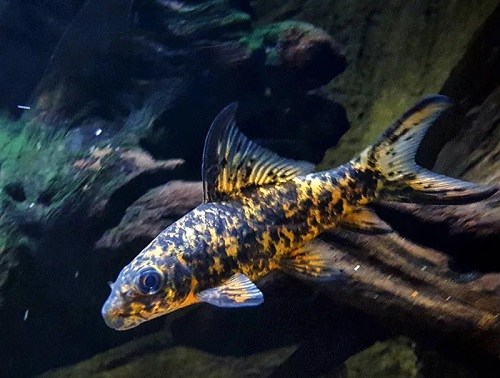
Credit: Rovfisk.se
- Scientific Name: Labeo cyclorhynchus
- Care Level: Intermediate
- Temperament: Aggressive
- Lifespan: 4–6 years
- Size: Up to 6 inches (15 cm)
- Tank Size: Minimum 55 gallons (208 liters)
- Water Parameters: 72–81°F (22–27°C), pH 6.0–7.5, hardness 5–15 dGH
- Diet: Omnivore
The Harlequin Shark is a unique and eye-catching freshwater fish known for its mottled, speckled coloration and bold personality. Although relatively small compared to other shark-like species, it makes up for its size with a highly territorial and assertive nature. Native to African river systems, this bottom-dwelling fish prefers environments filled with rocky caves and shaded hiding spots, where it can establish and fiercely defend its territory.
Unlike most freshwater “sharks,” which typically originate from Southeast Asia, the Harlequin Shark comes from Africa—a distinction that brings subtle differences in water parameter preferences. It is generally hardy but requires stable, well-maintained water conditions to avoid stress and illness. Weekly water changes and strong filtration are important to keep this sensitive fish in top condition, especially considering its shorter lifespan of around 4 to 6 years. This limited longevity makes consistent health monitoring essential.
The Harlequin Shark is best suited for experienced aquarists due to its aggression toward similar-looking fish or bottom-dwellers. To reduce territorial disputes, it should be introduced last into a tank where territories have already been established. Even then, it may chase or harass fish that enter its chosen space, so a thoughtful tank layout with ample hiding spots is critical. Large tanks of 55 gallons or more are necessary, with 75 gallons or more preferred in community setups.
In terms of decor, a natural aquascape with caves, rocks, and durable plants like Anubias helps define territories and gives the fish a sense of security. While not primarily herbivorous, Harlequin Sharks may nibble on delicate plants if underfed, so hardy plant choices and a varied diet are key. They feed well on sinking pellets, frozen or live invertebrates, and blanched vegetables such as spinach, with feedings given two to three times daily.
Compatible tank mates should be carefully selected. Mid- to top-dwelling fish like barbs or rainbowfish can work well, as they occupy different areas of the tank and are generally fast enough to avoid confrontation. Avoid other bottom-dwellers or similarly shaped fish, as well as smaller or passive species that may be bullied or injured.
With its bold presence and striking pattern, the Harlequin Shark adds both visual interest and complexity to well-planned aquariums. Though challenging, it rewards experienced keepers with fascinating behavior and a commanding presence when properly managed.
15. Violet Blushing Shark
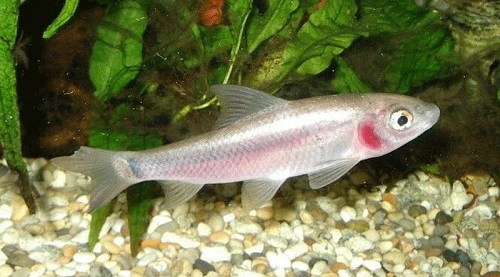
Credit: Sheree Armstrong
- Scientific Name: Labeo boga (not Epalzeorhynchos bicolor, which is likely a misidentification for Red Tail Shark)
- Care Level: Intermediate
- Temperament: Semi-aggressive
- Lifespan: Up to 10 years
- Size: Up to 12 inches (30 cm)
- Tank Size: Minimum 125 gallons (473 liters)
- Water Parameters: 72–81°F (22–27°C), pH 6.0–7.5, hardness 5–15 dGH
- Diet: Omnivore
The Violet Blushing Shark is an elegant, silvery fish with a soft violet sheen that becomes especially visible under the right lighting conditions. Often confused with the more aggressive Red Tail Shark due to common naming mistakes, this species is most likely Labeo boga, a distinct South Asian fish with its own care requirements and behavior profile. Native to the fast-moving rivers of the Indian subcontinent, the Violet Blushing Shark grows quite large and requires ample swimming space, making it best suited for sizable aquariums.
One of the most notable differences between this species and other members of the Labeo genus is its tolerance for conspecifics. While many Labeos are solitary and territorial, the Violet Blushing Shark can be kept in groups of five or more when housed in a large enough tank. Schooling not only helps reduce aggression but also reveals more natural, dynamic behaviors that are rarely seen in solitary individuals.
Though semi-aggressive, this fish is generally more peaceful than species like the Harlequin or Black Sharkminnow. Still, careful selection of tank mates is essential. Ideal companions include larger, peaceful fish such as barbs or gouramis, while smaller fish or similarly shaped “shark-like” species may provoke territorial responses, especially in smaller environments. A tank of at least 125 gallons is required for a single specimen, with 200 gallons or more recommended for groups.
Aquascaping should include caves, driftwood, and hardy plants like Java Fern to offer both visual complexity and shelter. These fish are bottom-to-mid-level swimmers and appreciate moderate water flow with high oxygenation. A darker substrate and moderate lighting will help accentuate their subtle violet hues. Their shimmering body, paired with their calm, steady movement, makes them a graceful presence in large, thoughtfully designed tanks.
Feeding the Violet Blushing Shark is straightforward. A balanced diet of sinking pellets, live or frozen foods such as shrimp, and blanched vegetables like zucchini will support their color and overall health. Feeding two to three times daily in moderate portions is ideal.
With their relatively mild temperament, group tolerance, and beautiful iridescent tones, Violet Blushing Sharks make a rewarding addition to large community aquariums. When given enough space and a stable environment, they display a unique combination of size, color, and sociability that sets them apart from other shark-like freshwater species.
Conclusion
From the vibrant Glo Sharks to the massive Iridescent Shark, freshwater sharks offer a range of aesthetics and challenges for aquarium enthusiasts. Each species, from the peaceful Roseline Shark to the aggressive Black Sharkminnow, brings unique behaviors and requirements.
Key considerations include tank size (e.g., 300+ gallons for Iridescent or Chinese High-Fin Banded Sharks), water quality (pristine for Roseline Sharks), and compatibility (avoiding shark-like fish for territorial species like Red Tail or Harlequin Sharks). Planted tanks are viable for most species if plants are secure and diets are varied, but aggressive species may require extra care to prevent plant damage or tank mate conflicts.
Research and planning are crucial before adding these fish to your aquarium. By understanding their specific needs—such as schooling for Apollo Sharks, brackish water for Columbian Sharks, or cold water for Chinese High-Fin Banded Sharks—you can create a thriving, visually spectacular tank that showcases the dynamic beauty of these freshwater “sharks.”

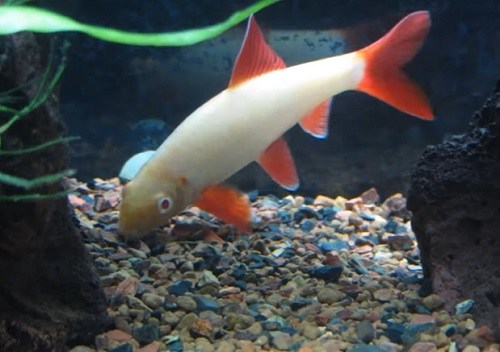 Albino Rainbow Shark #ad
Albino Rainbow Shark #ad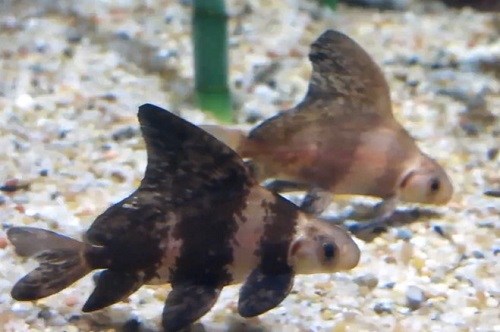 High-Fin Banded Shark #ad
High-Fin Banded Shark #ad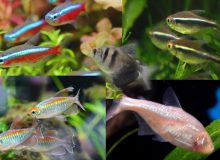
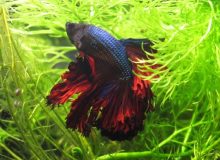
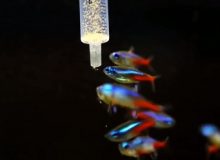
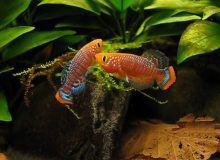

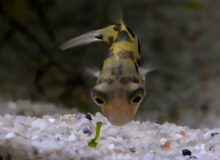
Leave a Reply